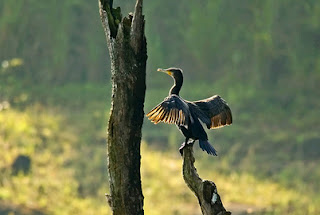
Biryani, biriani, or beriani: is a set of rice-based foods made with spices, rice (usually basmati) and meat, fish, eggs or vegetables. The name is derived from the Persian word beryā(n) (بریان) which means "fried" or "roasted".
Biryani was originated in Iran (Persia) and it was brought to the South Asia by Iranian travelers and merchants. Local variants of this dish are not only popular in South Asia but also in Arabia and within various South Asian communities in Western countries.
Ingredients
The spices and condiments used in biryani may include but are not limited to: ghee, cumin, cloves, cardamom, cinnamon, bay leaves, coriander, mint leaves, ginger, onions, and garlic. The premium varieties include saffron. For a non-vegetarian biryani, the main ingredient that accompanies the spices is the meat—beef, chicken, goat, lamb, fish or shrimp. The dish may be served with dahi chutney or Raita, korma, curry, a sour dish of eggplant (brinjal) or a boiled egg.
The difference between biryani and pullao is that while pullao may be made by cooking the items together, biryani is used to denote a dish where the rice (plain or fried) is cooked separately from the thick sauce (curry of meat or vegetables). The curry and the rice are then brought together and layered, resulting in a dish of the contrasting flavors of unflavored rice (which has a hint of the aromas and juices of the curry) and intensely flavored sauce and meat or vegetables.
Types
Hyderabadi Biryani
Non-vegetarian Hyderabadi Biryani is savored in all parts of India and forms an integral part of Indian cuisine. The Nizam’s kitchen boasted of 49 kinds, which included biryani made from fish, quail, shrimp, deer and hare. The most famous of all, Hyderabadi Biryani is called the "Kachi Akhni" Biryani as both the marinated meat and the rice are cooked together.
Dindigul Biriyani
Dindigul Biriyani- Dindigul is very famous for its Briyani and also called Briyani City. Briyani prepared in Dindigul uses a small rice called seeraga samba and with special ingredients.It gave tamilnadu the best of its taste. Thalappakatti in itself is a brand name which operates all over Tamilnadu with so many retail outlets. Venu Briyani, Ponram, Thulsi and Bangaru are the Best Briyani hotels in Dindigul. Aachi's also holds good in its flavour.
Iranian Biryani
In Safavid dynasty a dish called "Biryan Pilaf" was made with overnight marinated lamb/chicken - with yogurt, herbs, spices, dried fruits like raisins, prunes or pomegranate seeds - and later cooked in Tandoor / Tanoor oven. It was served with steamed rice. In its more original form, in some cities the dish is known with the general name of "Dam Pukht/Dam-pukhtak". The compound in Persian means "steam-cooked"—a reference to the steamed rice that forms the basis of the dish. This name is still in common use in Iran besides "biryani". In Southeast Asian countries such as Burma/Myanmar this older, general Persian term is in common use as 'danpauk'.
In city of Isfahan, Iran; a kind of Biryani is made with cooked mutton or lamb that is stewed then minced separately and then grilled in special small round shallow pans in the oven or over the fire. The burgers are generally served, with powdered cinnamon, in a local bread, usually "nan-e taftoon" but also sometimes "nan-e sangak".
Sindhi Biryani
The Sindhi Biryani variant of Biryani is very popular in Pakistani cuisine and Biryani of all types are eaten in all parts of Pakistan and the world. In Pakistan Biryani enjoys substantial popularity, particularly in the cities of Karachi and Hyderabad, where the chicken version is popular. most Biryani cuisines in Pakistan combine elements of Sindhi Biryani such as the common use of Yogurt recipes. The national flag carrier, PIA, also serves this cuisine for most of its western bound flights to give foreigners a feel of Pakistani cuisines.
There is also another meat free version prepared in the Punjab and northern areas of Pakistan that has proved quite popular and to meet the dietary requirements. The dish offers the usual local vegetables as well as a sour yogurt to cool off the stomach from the spices.
Memoni Biryani
Memoni biryani was developed by the Memon ethnic group and is very similar to Sindhi Biryani. It has variations though, among families, as do most biryanis, though the Batwa Memon community most commonly makes biryani in this form. Memoni biryani is made with lamb, yogurt, fried onions, and potatoes, and less tomatoes compared to Sindhi biryani. Memoni biryani also uses less food coloring compared to other biryanis, allowing the rich colors of the various meats, rice, and vegetables to blend without too much of the orange coloring. Memoni biryani is especially notable in Karachi, Pakistan.
Kacchi Biryani
Kacchi Biryani is a special preparation of the dish which is cooked with mutton (and rarely with Chicken). The dish is cooked with the meat and sauce being at the bottom of the cooking pot with a thick layer of rice on top, the rice and meat are mixed before serving. Potatoes are sometimes also added to the dish which is cooked with the meat. A boiled egg and mixed salad often accompanies the dish. This is one of the most popular delicacy of Old Dhaka, Bangladesh.
Tahari
Tahari or Tahri is the name given to the vegetarian version of the Biryani and is very popular in Pakistani and Indian homes. In Bangladesh, Tehri refers to Biryani prepared by adding the meat to the rice, as opposed to traditional Biryani where the rice is added to the meat.
Lucknowi (Awadhi) Biryani
Lucknow and biryani have an almost symbiotic relationship. The Lucknow (Awadhi) biryani is the footprint that the Muslims of the Mughal Empire left on the northern part of India. It originated in the village 'Bare Next' and although it originated in the North, Virani Biryani has also picked up flavors of the South. The Awadhi Biryani is also known as "Pukka" Biryani as the rice and meat are cooked separately and then layered.
Calcutta Biryani
The third in the list of famous Biriyanis, Calcutta or Kolkata biryani evolved from the Lucknow style when Wajid Ali Shah, the last nawab of Awadh was exiled in 1856 to the Kolkata suburb of Metiabruz. When the biryani entered poorer homes in the city that could not afford meat, at least on a regular basis, the meat was replaced by potatoes. Now the use of potatoes has become a distinct feature of the Calcutta biryani as an additional ingredient along with the meat. In addition, Calcutta biriyani is much lighter on masala and more subtle, unlike its Hyderabadi counterpart.
Kozhikode Biryani
The Kozhikode Biriyani variant of biryani is very popular in Kerala cuisine introduced by Muslims. This preparation is popular across the coast of Kerala—the Malabar region particularly. The biriyani may contain chicken, mutton or fish as the main ingredient. The biriyani is quite different from others across India in that the rice used is generally mixed with ghee to produce a very rich flavour. Although local spices such as nutmeg, cashew, cloves and cinnamon are used, there is only a small amount of chilli (or chilli powder) used in the preparation making the dish much less spicy in comparison to other biriyanis from across India. It is also known as Thalasseri biriyani.
Danbauk
In Myanmar, biryani, known in Burmese as danpauk/danbauk or danpauk htamin is popular. Popular ingredients are cashew nuts, yogurt, raisins and peas, chicken, cloves, cinnamon, saffron and bayleaf. In Burmese biryani, the chicken is cooked with the rice. Biryani is also eaten with a salad of sliced onions and cucumber. In Yangon, there are several restaurant chains that serve biryani exclusively. It is often served at religious ceremonies and luncheons. Biryani in Myanmar utilizes a special rice grown domestically rather than basmati.
Thallapakattu Briyani
This variety of briyani is quite popular in south india particularly in tamil nadu.There are quite a number of hotels serving this type of briyani.Thallapakattu literally means turban in Tamil.
Thai Biryani
In Thailand, Thai Muslims have popularized a local variety of the dish, known as Khao mok, which is popular throughout the country.Chicken and beef are the most common form but there is also a goat version that is eaten almost exclusively by the Muslim population. Along with Thai Massaman curry and satay it is one of the most notable Muslim Thai dishes. Biryani is also another name for heena.
Sri Lankan Biryani
Malay Biryani prepared with Sri Lankan Spices
In Sri Lanka Biryani is most popular amongst Muslims and is usually served with chicken, beef or mutton. In many cases, Sri Lankan biryani is much spicier than most Indian varieties. Popular side dishes include Acchar, Malay Pickle, cashew curry and
Ground Mint Sambol.
A popular form of biryani uses string hoppers as a substitute for rice. It is often served with scrambled eggs or vegetables.
Malaysia's Nasi Beriani
In Malaysia and Singapore, the dish is called Nasi Beriani or Nasi Beryani or Nasi Briani or Nasi Minyak. It is commonly served with Rendang dish and Sirap Bandung beverage especially during wedding receptions of Muslim Malays community. Nasi Beriani Gam, a special version of the dish is famous and favourite in the southern Malaysian state of Johor, especially in Muar and Batu Pahat.
Singapore
In Singapore, the dish is called Nasi Biryani by the Malays or simply Biryani by the Indians. It is a very popular dish amongst the largely South Indian community of the Indian minority and the ethnic Malay-Muslim community, being a choice serving at weddings of both these communities. There are also speciality restaurants, commonly in Little India and Arab Street, and also regular Indian Muslim food stalls in coffee-shops all over the island that serve several types of briyani; distinctly Indian or Malay. The very common types come in either the chicken, mutton or fish versions, always accompanied with Achar (a pickled combination of cucumbers, onions, red chillies and pineapples) or Raita and a hard-boiled egg (in South Indian versions only). There are also Afghan, Iranian and Turkish manifestations of this dish available in some restaurants.
Filipino Dish
In the Philippines, Biryani dishes exists in the Pampanga region of the northern island of Luzon, and in the predominantly Muslim areas of the southern island of Mindanao and the Sulu archipelago. The Kapampangan Nasing Biringyi is related to the Malay Nasi Beriani, see Kapampangan cuisine.
In the southern island of Mindanao, biryani style rice dishes are served during big celebrations.
Shrimp Biryani
This particular variation of Biryani brings out the tender and delicate flavor of shrimp. Unlike other kinds of biryanis, it's quicker to prepare and doesn't require long hours of complex marinating procedures. It's usually served with a side of baingan masaledar.



















+Biryani.jpg)










.jpg)

































